Scientific name Equisetum | ||
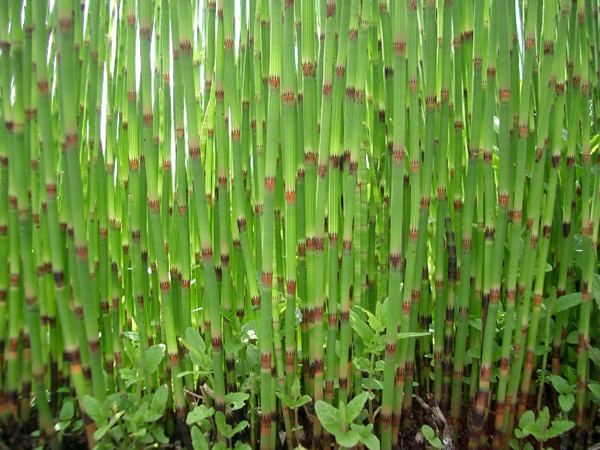 | ||
Lower classifications Field horsetail, Equisetum hyemale, Equisetum palustre, Equisetum telmateia, Equisetum sylvaticum | ||
Equisetum (/ˌɛKwᵻˈSiːTəm/; horsetail, snake grass, puzzlegrass) is the only living genus in Equisetaceae, a family of vascular plants that reproduce by spores rather than seeds.
Contents
- Equisetum hyemale releases spores
- Etymology
- Description
- Spores
- Equisetum cell walls
- Species
- Named hybrids
- Distribution ecology and uses
- Medicinal uses
- References
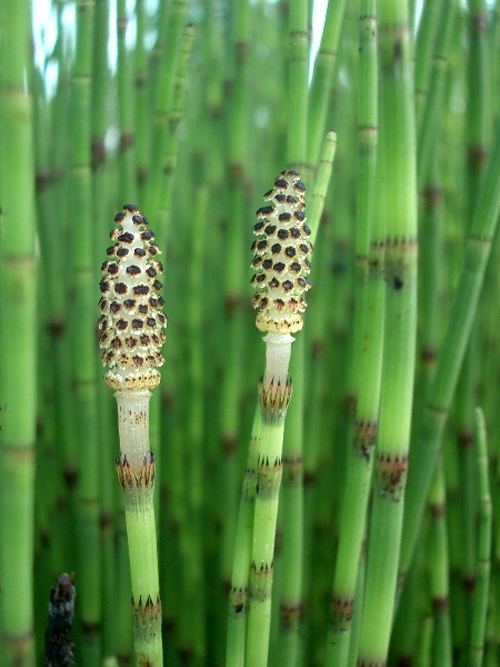
Equisetum is a "living fossil" as it is the only living genus of the entire class Equisetopsida, which for over one hundred million years was much more diverse and dominated the understory of late Paleozoic forests. Some Equisetopsida were large trees reaching to 30 meters tall. The genus Calamites of the family Calamitaceae, for example, is abundant in coal deposits from the Carboniferous period.
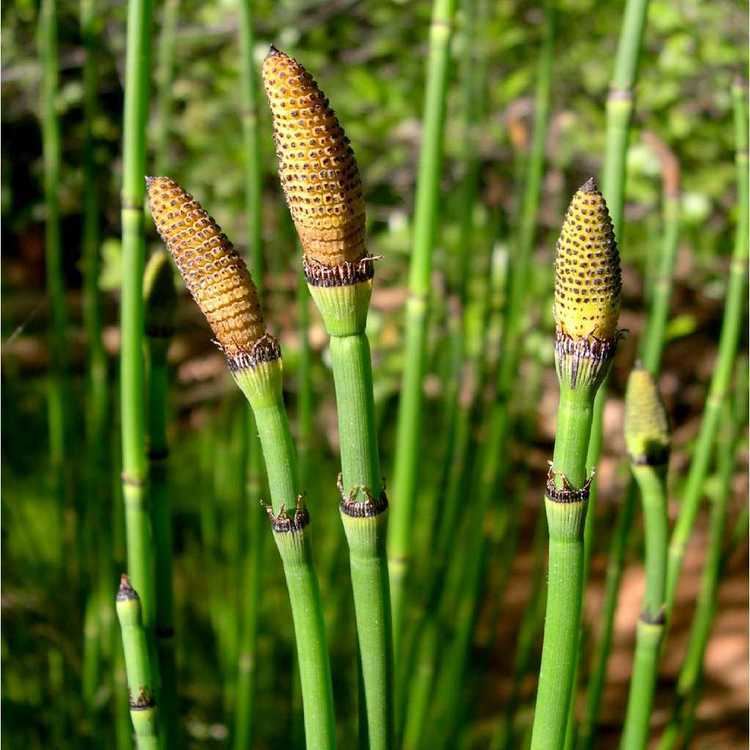
A superficially similar but entirely unrelated flowering plant genus, mare's tail (Hippuris), is occasionally referred to as "horsetail", and adding to confusion, the name mare's tail is sometimes applied to Equisetum.
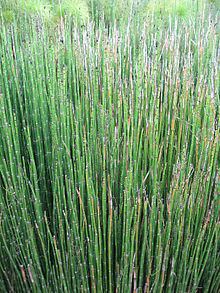
The pattern of spacing of nodes in horsetails, wherein those toward the apex of the shoot are increasingly close together, inspired John Napier to discover logarithms.
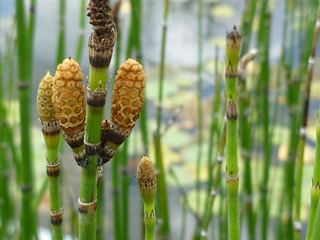
Equisetum hyemale releases spores
Etymology
The name "horsetail", often used for the entire group, arose because the branched species somewhat resemble a horse's tail. Similarly, the scientific name Equisetum derives from the Latin equus ("horse") + seta ("bristle").
Other names include candock for branching individuals, and snake grass or scouring-rush for unbranched or sparsely branched individuals. The latter name refers to the rush-like appearance of the plants, and to the fact that the stems are coated with abrasive silicates, making them useful for scouring (cleaning) metal items such as cooking pots or drinking mugs, particularly those made of tin. In German, the corresponding name is Zinnkraut ("tin-herb"). Rough horsetail E. hyemale is still boiled and then dried in Japan, to be used for the final polishing process on woodcraft to produce a smoother finish than any sandpaper. In Spanish-speaking countries, these plants are known as "cola de caballo," meaning "horsetail."
Description
In these plants the leaves are greatly reduced and usually non-photosynthetic. They contain a single, non-branching vascular trace, which is the defining feature of microphylls. However, it has recently been recognised that horsetail microphylls are probably not ancestral as in Lycopodiophyta (clubmosses and relatives), but rather derived adaptations, evolved by reduction of megaphylls. They are, therefore, sometimes referred to as megaphylls to reflect this homology.
The leaves of horsetails are arranged in whorls fused into nodal sheaths. The stems are usually green and photosynthetic, and are distinctive in being hollow, jointed and ridged (with sometimes 3 but usually 6-40 ridges). There may or may not be whorls of branches at the nodes.
Spores
The spores are borne under sporangiophores in strobili, cone-like structures at the tips of some of the stems. In many species the cone-bearing shoots are unbranched, and in some (e.g. field horsetail, E. arvense) they are non-photosynthetic, produced early in spring. In some other species (e.g. marsh horsetail, E. palustre) they are very similar to sterile shoots, photosynthetic and with whorls of branches.
Horsetails are mostly homosporous, though in the field horsetail smaller spores give rise to male prothalli. The spores have four elaters that act as moisture-sensitive springs, assisting spore dispersal through crawling and hopping motions after the sporangia have split open longitudinally.
Equisetum cell walls
The crude cell extracts of all Equisetum species tested contain mixed-linkage glucan : Xyloglucan endotransglucosylase (MXE) activity. This is a novel enzyme and is not known to occur in any other plants. In addition, the cell walls of all Equisetum species tested contain mixed-linkage glucan (MLG), a polysaccharide which, until recently, was thought to be confined to the Poales. The evolutionary distance between Equisetum and the Poales suggests that each evolved MLG independently. The presence of MXE activity in Equisetum suggests that they have evolved MLG along with some mechanism of cell wall modification. The lack of MXE in the Poales suggests that there it must play some other, currently unknown, role. Due to the correlation between MXE activity and cell age, MXE has been proposed to promote the cessation of cell expansion.
Species
The living members of the genus Equisetum are divided into two distinct lineages, which are usually treated as subgenera. The name of the type subgenus, Equisetum, means "horse hair" in Latin, while the name of the other subgenus, Hippochaete, means "horse hair" in Greek. Hybrids are common, but hybridization has only been recorded between members of the same subgenus. While plants of subgenus Equisetum are usually referred to as scouring rushes, those of subgenus Hippochaete are often called scouring rushes, especially when unbranched.
Two Equisetum plants are sold commercially under the names Equisetum japonicum (barred horsetail) and Equisetum camtschatcense (Kamchatka horsetail). These are both types of E. hyemale var. hyemale, although they may also be listed as varieties of E. hyemale.
Named hybrids
Distribution, ecology and uses
The genus Equisetum as a whole, while concentrated in the non-tropical northern hemisphere, is near-cosmopolitan, being absent only from Antarctica, though they are not known to be native to Australia, New Zealand nor the islands of the Pacific. They are most common in northern North America (Canada and the northernmost United States), where the genus is represented by nine species (arvense, fluviatile, palustre, pratense, sylvaticum, hyemale, laevigatum, scirpoides, and variegatum). Only four (bogotense, giganteum, myriochaetum, and ramosissimum) of the fifteen species are known to be native south of the Equator. They are perennial plants, herbaceous and dying back in winter as most temperate species, or evergreen as most tropical species and the temperate species rough horsetail (E. hyemale), branched horsetail (E. ramosissimum), dwarf horsetail (E. scirpoides) and variegated horsetail (E. variegatum). They typically grow 0.2-1.5 m tall, though the "giant horsetails" are recorded to grow as high as 2.5 m (northern giant horsetail, E. telmateia), 5 m (southern giant horsetail, E. giganteum) or 8 m (Mexican giant horsetail, E. myriochaetum), and allegedly even more.
Many species in this genus prefer wet sandy soils, while others are adapted to wet clay soils. One species, Equisetum fluviatile, is an emergent aquatic, rooted in water with shoots growing into the air. The stalks arise from rhizomes that are deep underground and difficult to dig out. The field horsetail (E. arvense) can be a nuisance weed, readily regrowing from the rhizome after being pulled out. It is unaffected by many herbicides designed to kill seed plants. However, as E. arvense prefers an acid soil, lime may be used to assist in eradication efforts to bring the soil pH to 7 or 8. Members of the genus have been declared noxious weeds in Australia and in the US state of Oregon.
All the Equisetum are classed as "unwanted organisms" in New Zealand and are listed on the National Pest Plant Accord.
If eaten over a long enough period of time, some species of horsetail can be poisonous to grazing animals, including horses. The toxicity appears to be due to thiaminase enzymes, which can cause thiamine (vitamin B1) deficiency. People have regularly consumed horsetails. The young plants are eaten cooked or raw, but considerable care must be taken. For example, the fertile stems bearing strobili of some species are cooked and eaten like asparagus (a dish called tsukushi) in Japan. The people of ancient Rome would eat meadow horsetail in a similar manner, and they also used it to make tea as well as a thickening powder. Native Americans in the Pacific Northwest eat the young shoots of this plant raw. The plants are used as a dye and give a soft green colour. An extract is often used to provide silica for supplementation. Horsetail was often used by Indians to polish wooden tools. Equisetum species are often used to analyze gold concentrations in an area due to their ability to take up the metal when it is in a solution.
Medicinal uses
Extracts and other preparations of E. arvense have served as herbal remedies, with records dating to ancient Greek and Roman medical sources; its reported uses include treatments to stop bleeding, treat tuberculosis, to heal wounds and ulcerations, and to treat kidney ailments. Equisetum arvense has long been used in dried form as an external application to slow bleeding and promote clotting. Reliable modern alternative medicine sources include cautions with regard to its use. In 2009 the European Food Safety Authority issued a report assessing some specific health claims for E. arvense—e.g., for invigoration, weight control, and skin, hair, and bone health—concluding that none could be substantiated. There is thus insufficient evidence to draw conclusions regarding its effectiveness as a medicine for all human conditions described. Even so, E. giganteum preparations are widely used in South America as an orally administered diuretic to reduce swelling caused by excess fluid retention and for urinary infections, bladder and kidney disorders. Horsetail preparations contain silicon, so they are sometimes suggested as a treatment for osteoporosis (brittle bone disorders).
